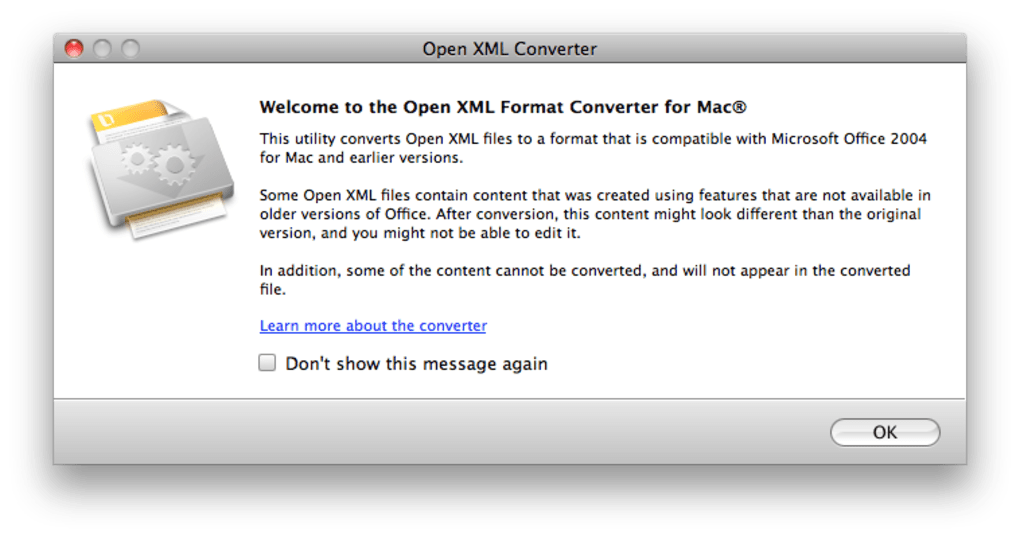MSXML 6.0 (MSXML6) has improved reliability, security, conformance with the XML 1.0 and XML Schema 1.0 W3C Recommendations, and compatibility with System.Xml 2.0. Microsoft Office Open XML Converter for Mac OS X can convert Office Open XML files to the former binary file formats used in older versions of Microsoft Office. 34 OxygenOffice includes xmlfilter which is the code that OpenOffice.org 3 will use to process Office Open XML files, and xmlfilter is completely different from OdfConverter. Microsoft Xml V6.0 For Excel Mac 2011 14 1 Status Bar Missing; In the Microsoft Office 2011 14.7.7 Update volume window, double-click the Office 2011 14.7.7 Update application to start the update process, and then follow the instructions on the screen. If the installation finishes successfully, you can remove the update installer from your hard.
-->This topic describes how to install, configure, update, and use Defender for Endpoint for Mac.
Caution
Running other third-party endpoint protection products alongside Defender for Endpoint for Mac is likely to lead to performance problems and unpredictable side effects. If non-Microsoft endpoint protection is an absolute requirement in your environment, you can still safely take advantage of MDATP for Mac EDR functionality after configuring MDATP for Mac antivirus functionality to run in Passive mode.
What’s new in the latest release
Tip
If you have any feedback that you would like to share, submit it by opening Microsoft Defender for Endpoint for Mac on your device and navigating to Help > Send feedback.
To get the latest features, including preview capabilities (such as endpoint detection and response for your Mac devices), configure your macOS device running Microsoft Defender for Endpoint to be an 'Insider' device.
How to install Microsoft Defender for Endpoint for Mac
Prerequisites
- A Defender for Endpoint subscription and access to the Microsoft Defender Security Center portal
- Beginner-level experience in macOS and BASH scripting
- Administrative privileges on the device (in case of manual deployment)
Installation instructions
There are several methods and deployment tools that you can use to install and configure Defender for Endpoint for Mac.
Third-party management tools:
Command-line tool:
System requirements
The three most recent major releases of macOS are supported.
Important
On macOS 11 (Big Sur), Microsoft Defender for Endpoint requires additional configuration profiles. If you are an existing customer upgrading from earlier versions of macOS, make sure to deploy the additional configuration profiles listed on New configuration profiles for macOS Catalina and newer versions of macOS.
Important
Support for macOS 10.13 (High Sierra) will be discontinued on February 15th, 2021.
- 11 (Big Sur), 10.15 (Catalina), 10.14 (Mojave), 10.13 (High Sierra)
- Disk space: 1GB
Beta versions of macOS are not supported.
After you've enabled the service, you may need to configure your network or firewall to allow outbound connections between it and your endpoints.
Licensing requirements
Microsoft Defender for Endpoint for Mac requires one of the following Microsoft Volume Licensing offers:
- Microsoft 365 E5 (M365 E5)
- Microsoft 365 E5 Security
- Microsoft 365 A5 (M365 A5)
Note
Eligible licensed users may use Microsoft Defender for Endpoint on up to five concurrent devices.Microsoft Defender for Endpoint is also available for purchase from a Cloud Solution Provider (CSP). When purchased via a CSP, it does not require Microsoft Volume Licensing offers listed.
Network connections
The following downloadable spreadsheet lists the services and their associated URLs that your network must be able to connect to. You should ensure that there are no firewall or network filtering rules that would deny access to these URLs, or you may need to create an allow rule specifically for them.
| Spreadsheet of domains list | Description |
|---|---|
| Spreadsheet of specific DNS records for service locations, geographic locations, and OS. Download the spreadsheet here: mdatp-urls.xlsx. |
Microsoft Defender for Endpoint can discover a proxy server by using the following discovery methods:
- Proxy autoconfig (PAC)
- Web Proxy Autodiscovery Protocol (WPAD)
- Manual static proxy configuration
If a proxy or firewall is blocking anonymous traffic, make sure that anonymous traffic is permitted in the previously listed URLs.
Warning
Authenticated proxies are not supported. Ensure that only PAC, WPAD, or a static proxy is being used.
SSL inspection and intercepting proxies are also not supported for security reasons. Configure an exception for SSL inspection and your proxy server to directly pass through data from Microsoft Defender for Endpoint for Mac to the relevant URLs without interception. Adding your interception certificate to the global store will not allow for interception.
To test that a connection is not blocked, open https://x.cp.wd.microsoft.com/api/report and https://cdn.x.cp.wd.microsoft.com/ping in a browser.
If you prefer the command line, you can also check the connection by running the following command in Terminal:
The output from this command should be similar to the following:
OK https://x.cp.wd.microsoft.com/api/report
OK https://cdn.x.cp.wd.microsoft.com/ping
Caution
We recommend that you keep System Integrity Protection (SIP) enabled on client devices. SIP is a built-in macOS security feature that prevents low-level tampering with the OS, and is enabled by default.
Once Microsoft Defender for Endpoint is installed, connectivity can be validated by running the following command in Terminal:
How to update Microsoft Defender for Endpoint for Mac
Microsoft regularly publishes software updates to improve performance, security, and to deliver new features. To update Microsoft Defender for Endpoint for Mac, a program named Microsoft AutoUpdate (MAU) is used. To learn more, see Deploy updates for Microsoft Defender for Endpoint for Mac.

How to configure Microsoft Defender for Endpoint for Mac
Guidance for how to configure the product in enterprise environments is available in Set preferences for Microsoft Defender for Endpoint for Mac.
macOS kernel and system extensions
In alignment with macOS evolution, we are preparing a Microsoft Defender for Endpoint for Mac update that leverages system extensions instead of kernel extensions. For relevant details, see What's new in Microsoft Defender for Endpoint for Mac.
Resources
For more information about logging, uninstalling, or other topics, see Resources for Microsoft Defender for Endpoint for Mac.
Privacy for Microsoft Defender for Endpoint for Mac.
Microsoft XML Core Services (MSXML) are set of services that allow applications written in JScript, VBScript, and Microsoft development tools to build Windows-native XML-based applications. It supports XML 1.0, DOM, SAX, an XSLT 1.0 processor, XML schema support including XSD and XDR, as well as other XML-related technologies.
Overview[edit]
All MSXML products are similar in that they are exposed programmatically as OLE Automation (a subset of COM) components. Developers can program against MSXML components from C, C++ or from Active Scripting languages such as JScript and VBScript. Managed .NET Interop with MSXML COM components is not supported nor recommended.[1]
As with all COM components, an MSXML object is programmatically instantiated by CLSID or ProgID. Each version of MSXML exposes its own set of CLSID's and ProgIDs. For example, to create an MSXML 6.0 DOMDocument object, which exposes the IXmlDomDocument,[2]IXmlDomDocument2,[3] and IXmlDomDocument3[4] COM interfaces, the ProgID 'MSXML2.DOMDocument.6.0' must be used.
MSXML also supports version-independent ProgIDs. Version-independent ProgIDs do not have a version number associated with them. For example, 'Microsoft.XMLHTTP'. These ProgIDs were first introduced in MSXML 1.0, however are currently mapped to MSXML 3.0 objects and the msxml3.dll.

Different versions of MSXML support slightly different sets of functionality. For example, while MSXML 3.0 supports only XDR schemas, it does not support XSD schemas. MSXML 4.0, MSXML 5.0, and MSXML 6.0 support XSD schemas. However, MSXML 6.0 does not support XDR schemas. Support for XML Digital Signatures is provided only by MSXML 5.0. For new XML-related software development, Microsoft recommends[5] using MSXML 6.0 or its lightweight cousin, XmlLite, for native code-only projects.[6]
Versions[edit]
MSXML is a collection of distinct products, released and supported by Microsoft. The product versions can be enumerated as follows:[7] More information on each version is also available at Microsoft Downloads website.
Current[edit]
- MSXML 6.0 MSXML6 is the latest MSXML product from Microsoft, and (along with MSXML3) is shipped with Microsoft SQL Server 2005, Visual Studio 2005, .NET Framework 3.0, Windows Vista, Windows 7 and Windows XP Service Pack 3. It also has support for native 64-bit environments. It is an upgrade but not replacement for versions 3 and 4 as they still provide legacy features not supported in version 6. Version 6, 4, and 3 may all be installed and running concurrently. MSXML 6 is not supported on Windows 9x. Windows XP SP3 includes MSXML 6.0 SP2.
- MSXML 3.0 MSXML3 is a current MSXML product, represented by msxml3.dll. MSXML 3.0 SP2 first shipped with Windows XP, Internet Explorer 6.0 and MDAC 2.7. Windows XP SP2 includes MSXML 3.0 SP5 as part of MDAC 2.81. Windows 2000 SP4 also ships with MSXML 3.0. By default, Internet Explorer version 6.0, 7.0 and 8.0 use MSXML 3 to parse XML documents loaded in a window. MSXML 3.0 SP7 is the last supported version for Windows 95. Windows XP SP3 includes MSXML 3.0 SP9. Windows Vista also includes MSXML 3.0 (SP10).
Obsolete[edit]
- MSXML 5.0 MSXML5 was a binary developed specifically for Microsoft Office. It originally shipped with Office 2003 and also ships with Office 2007. Microsoft has not released documentation for this version because Microsoft considers MSXML 5 an internal/integrated component of Office 2003. MSXML 5 is not included in Office 2010.[8]
- MSXML 4.0 MSXML4 was shipped as an independent, downloadable SDK targeted at independent software vendors and third parties. It is an upgrade for, but not a replacement to MSXML3 as version 3 still provides legacy features. There is no 64-bit version offered, although the 32-bit version was supported for 32-bit processes on 64-bit operating systems. Versions 4 and 3 may be run concurrently. MSXML 4.0 SP3 is the most recent version released in March 2009, SP2 support expired in April 2010,[9] and MSXML 4.0 SP3 expired in April 2014.[10]
- MSXML 2.6 This is an early version of MSXML, and is represented by msxml2.dll. This product is no longer supported by Microsoft, and the CLSIDs and ProgIDs it exposes have been subsumed by MSXML 3.0. MSXML 2.6 shipped with Microsoft SQL Server 2000 and MDAC 2.6. The last version for all platforms was released as KB887606.
- MSXML 2.5 This is an early version of MSXML, and is represented by msxml.dll. This version is also no longer supported by Microsoft, and the CLSIDs and ProgIDs it exposes have been subsumed by MSXML 3.0. MSXML 2.5 shipped with Windows 2000 as part of Internet Explorer 5.01 and MDAC 2.5.
- MSXML 2.0a This version shipped with Internet Explorer 5.0. No longer supported.
- MSXML 1.0 This version shipped with Internet Explorer 4.0. No longer supported.
See also[edit]
References[edit]
- ^'The use of MSXML is not supported in .NET applications'. Microsoft. Retrieved 2010-03-18.
- ^'IXMLDOMDocument/DOMDocument'. MSDN. Retrieved 2008-05-28.
- ^'IXMLDOMDocument2'. MSDN. Retrieved 2008-05-28.
- ^'IXMLDOMDocument3'. MSDN. Retrieved 2008-05-28.
- ^'Using MSXML in the browser'. Retrieved 2008-05-28.
- ^'XmlLite Programmers' Guide and API Reference'. MSDN. Retrieved 2008-05-28.
- ^MSXML Version List at Microsoft.
- ^Office 2010: What's removed: Office 2010 Resource Kit documentation on TechNet
- ^MSXML 4.0 SP3 Release Notes, Microsoft, 2009-09-29, retrieved 2011-01-21
- ^MSXML Roadmap, Microsoft, 2013-03-15, retrieved 2015-07-11
External links[edit]
- Microsoft XML Team's WebLog
Microsoft Xml Converter Download
